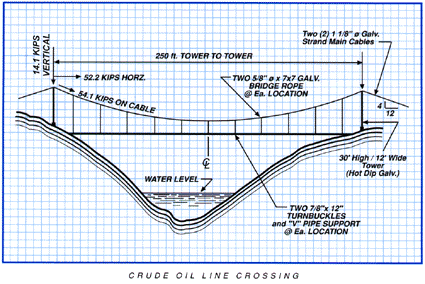Engineering
SEFBO Will Provide:
Aerial pipeline crossing designs with detailed shop drawings of towers, cable systems, pipeline supports, foundations, and anchors.
Our engineering department can furnish all required engineering services worldwide including seismic analysis.
Our designs are based upon many years of observing what takes place on a crossing under actual operating conditions in the field.
A design that cuts lifetime maintenance costs in half while saving on original installation costs is SEFBO's design criteria. At the same time, we impose strict safety factor considerations in every design.

Inspection
An inspection program by experienced pipeline bridge inspectors is the prime factor in controlling maintenance costs.
Benefits Include:
Third Party Verification of your crossings condition. (You know how important this may be in the future!)
Detection of problems at an early stage when they can be resolved more economically and on a predetermined schedule.
Coating systems can be monitored and recoating work scheduled only when it's required.
All cable supported crossing should be inspected every three years with crossings near a coastline or in a very heavy industrial area inspected every year.
From a small 200 ft. creek crossing to a 3,600 ft. river crossing every crossing is equally important to your pipeline system's integrity. Let us track their condition for you.

Seismic Analysis and Retrofit
Does your bridge satisfy the current structural code requirements?:
Sefbo Technology, Inc. recognizes that many existing structures and most new bridge structures require earthquake design to safeguard against structural failures and to limit damage, particularly if they are located in earthquake zones 3 and 4. What makes seismic analysis unique and difficult for suspension bridges is that in addition to the combinations of other structural components such as steel towers, pipeline supports and concrete foundations one must also determine the dynamic response of the cable system. Most engineers and studies do not contemplate the response of a cable. At Sefbo our engineers not only can create a bridge that will resist the effects of contemplated seismic ground motions, they also strive to produce economic solutions.
Dynamic Analysis – Preferably, all structures require some dynamic analyses procedures, which necessitate the appropriate ground motion representation. Sefbo engineers create a mathematical model to represent the physical structure, which shows the spatial distribution of the mass and stiffness of the structure to the extent necessary to perform adequate calculation.
Equivalent Lateral Forces – A bridge can be engineered and constructed for ground motion producing structural response and seismic forces in any horizontal direction. By using static force procedure, determining seismic factors, understanding the vertical and horizontal distribution, the impact of overturning, drift, and story limitation the proper design, theoretically, can be achieved. However, this method quite often yields a product that is to conservative to be cost effective.
Modal Superposition – A simplified structural model with lumped mass is used to create the structural model. This method may work for a smaller bridge but does not yield enough information for longer or more complex crossings.
Design Response Spectrum Analysis – This is a form of elastic dynamic analysis using the peak dynamic response of all significant modes to determine the structural response. It is a representation of the design basis ground motion, based on certain geological, tectonic, seismological and soil characteristics associated with a specific site. From this Sefbo engineers can usually determine the dynamic effects of an earthquake upon certain aspects of the bridge structure.
Time-History Analysis – This is an analysis of the dynamic response of a structure when the base is subjected to a specific ground motion time history.
Non-Linear Time-History Analysis – When time history is not available, a very detailed and thorough analysis of the lateral force system must be reviewed. Capacities and characteristics of the nonlinear elements shall be modeled with test data or substantiated analysis taking into consideration many factors.
The basis for design and seismic retrofit depend on the seismic zoning, the site characteristics, configuration and structural system and height of a particular bridge. Our seismic design meets Uniform Building Code (UBC) requirements.
